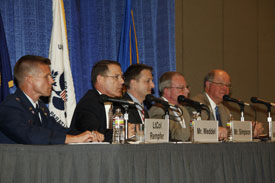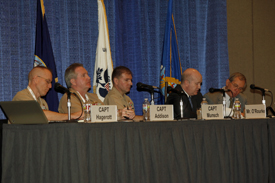West 2011 Online Show Daily: Game-Changing Environment Vexes Planners
Predicting the next conflict takes a back seat to flexible planning.
Quote of the Day:
“We may not be able to conduct our favorite American way of war in the future.”—Dick Diamond Jr., national security trends and strategic issues analyst, Raytheon Integrated Defense Systems
The dynamic environment that defines trends from social development to technology innovation is wreaking havoc with attempts to plan an effective national security structure. Coupled with severe budget limitations arising from the global economic crisis, this rapidly changing milieu is revolutionizing warfighting in ways that cannot be countered—or even predicted—on short notice. Many of these issues that pertain to naval operations were discussed on the first day of West 2011, presented by AFCEA International and USNI January 25-27, 2011 in San Diego. Titled “After the Long War: What’s Next?” the program is focusing on technologies and trends that are changing the way adversaries fight.
For its part, the U.S. Navy must adopt a holistic approach to operational missions, offered Vice Adm. Richard W. Hunt, USN, commander, U.S. Third Fleet. Giving the Kickoff Address, Adm. Hunt said that the United States must conduct operations geared toward winning over countries instead of taking their support for granted.
Adm. Hunt singled out humanitarian assistance as one way of building U.S. strength among diverse countries. He noted that many nations “could go either way” in supporting or opposing U.S. national interests, and the United States could swing them into its support column by providing rapid and effective relief in the event of a disaster.
“It’s not just kinetic power … we must be a global force for good,” Adm. Hunt declared.
However, the fleet commander did not belittle the importance of kinetic operations. He warned that U.S. naval forces had become too defensive in their outlook and needed to adopt a greater emphasis on offensive capabilities. He cited missile defense and cyberspace security as two areas where too much emphasis had been placed on defense, and he called for a renewed emphasis on strike.
“We’ve stepped away and become too defensive,” the admiral declared.
| |
| Vice Adm. Richard W. Hunt, USN, commander, U.S. Third Fleet gives the Kickoff Address at West 2011 in San Diego. |
Adm. Hunt called for the Navy to develop offensive capabilities to take the fight to the adversary instead of merely being reactive. In particular, he said that defending cyberspace is necessary, but the force also needs to focus on an effective offensive cyberspace capability—“look at it from a warfighter perspective,” he suggested. “If we lose our computers … the way we operate today cripples us completely.”
One challenge the United States faces is the potential for a high-end conflict from a peer competitor. Technology advances are leveling the battlefield, and the United States must address that technologically and strategically. This and other challenges are compounded by global changes such as climate change—which may increase the amount of navigable seas as the North polar icecap melts—the global economic crisis, globalization, resource competition from emerging giants such as China and India, and globalization in general.
Some of those concerns were echoed by Tuesday’s luncheon speaker, Maj. Gen. Melvin G. Spiese, USMC, deputy commanding general, 1 Marine Expeditionary Force. Gen. Spiese also warned that nations, including friends, will act in their own interests, so the United States could have difficulty assembling an alliance or even getting support from some allies. Because nations change their policies over time as their national interests shift, the United States should not place itself in a position where addressing U.S. concerns depends on the policies of another nation.
Gen. Spiese added his observations about how global changes are compounding the military’s mission. The Corps is pursuing a dual-track approach to meeting its challenges. It is strengthening its traditional expertise in amphibious operations, which are likely to grow in importance with the majority of the world’s population living in littoral areas. And, it will pursue innovative tactics and technologies to meet emerging challenges.
Noting that the Marine Corps is a capabilities-based force rather than a platform-centric one, the general related that it is experimenting with new tactical organizations in its warfighting laboratory. The Corps also is looking at new systems that would extend its capabilities in specialized areas.
“The U.S. Marine Corps has never met the nation’s needs by being conventional in its approach,” Gen. Spiese declared.
The advances being made by adversaries were cited by Dick Diamond Jr., national security trends and strategic issues analyst with Raytheon Integrated Defense Systems. While moderating a panel on unmanned systems, Diamond expounded on how the vaunted U.S. military technological superiority may be waning as other countries acquire advanced technologies at an affordable price. Precision-guided munitions and surveillance in particular now can be had by foes who will use them to upset U.S. warfighting doctrine.
“We may not be able to conduct our favorite American way of war in the future,” Diamond said.
He explained that the United States may not have the luxury of being able to position forces forward for a period of time so that they can commence fighting at a time of their choosing. These forces would be vulnerable to other countries that are procuring high-technology weapons at affordable prices. As a result, maritime forces will need to be positioned farther away from shore.
One technology that might help U.S. forces steal a march from an adversary is unmanned aerial systems, or UASs. Dave Weddel, assistant deputy chief of naval operations for information dominance, described the future of naval UASs as exciting. They offer persistence, endurance and the ability to send aircraft where commanders might not want to send personnel.
 |
| Discussing the future of unmanned aerial systems are panelists (l-r) Lt. Col. Thomas Rempfer, USAF; Dave Weddel;; J. Terry Simpson; Rear Adm. Ben Wachendorf, USN (Ret.); and moderator Dick Diamond Jr. |
However, hurdles remain to be overcome for UASs to serve the force effectively. J. Terry Simpson, principal deputy for intelligence, Program Executive Office, C4I, pointed out that data flow can be a problem. One hour of multispectral imagery generates 1 terabyte of data, but the best Navy channels flow at 50 megabits per second. Simpson warned that the Navy must be smart about how it handles data ingestion, or adding new UASs could cause a network to reach its breaking point.
Rear Adm. Ben Wachendorf, USN (Ret.), chief operating officer, EchoStorm Worldwide and a former submariner, noted that UASs offer the potential to reduce personnel costs, which constitute 65 percent of the Navy budget.
Budgetary concerns hang over the entire Navy, and they threaten to derail vital modernization efforts. Capt. R. Robinson Harris, USN (Ret.), director, advanced concepts, Lockheed Martin Mission System and Sensors, cited studies warning that the growing national debt is a threat to national security. Ronald O’Rourke, a specialist in national defense with the Congressional Research Service, told a panel audience that the sea service already is underfunded for its shipbuilding requirements. Cuts in that area could have severe repercussions for the force.
Part of this was a result of the Navy not committing supplemental defense funding toward procurement. As a result, it does not have any procurement programs that it can cut.
“Some of the lower-hanging fruit in terms of efficiencies already have been picked,” O’Rourke said.
 |
| Tough budgetary decisions that might need to be implemented were the focus of panelists (l-r) Capt. Mark R. Hagerott, USN; Capt. Victor G. Addison, USN; Capt. Stuart B. Munsch, USN; Ronald O’Rourke; and moderator Capt. R. Robinson Harris, USN (Ret.). |
Efficiencies alone will not be sufficient to make budget cuts, he continued. The Navy likely will identify future efficiencies, but they might not be effective if the Navy is forced to make substantial budget cuts.
If the Navy is afflicted by severe cuts, it might cut back on ocean deployments by limiting them to a few chosen areas, O’Rourke suggested. Again, UASs could help meet capability goals, and the Navy could extend the operational lifetimes of some older ships and submarines.
Yet even severe budget cuts could be a boon to modernization. O’Rourke noted that, in the depression-ridden 1930s, the Navy had to develop new and innovative solutions to put to sea a force that could serve national security interests. Those innovations ultimately helped the Navy win its battle for Pacific supremacy against Japan.
Coming up on Day 2: Robert O. Work, undersecretary of the Navy; panels on air-sea battle and cyberwarfare; and a discussion on China hosted by David Hartman.




Comments